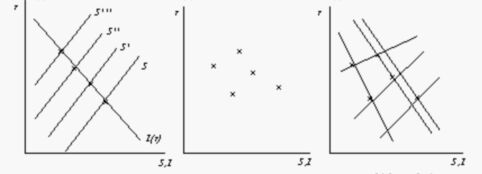| The figure below provides an illustration of the identification
problem for the specific example of the relationship between national savings,
investment and the interest rate. Macroeconomic theories we will study
differ in the predictions about the effect of changes in the interest rate,
r,
on saving, S, and investment, I. In particular, some theories
claim that investment is largely insensitive to changes r (i.e.
the investment curve should be very steep), while others say that the curve
should be quite flat. So why don't we just look at the data?The left panel
of the figure below shows what we want to see: how shifts in the national
saving function trace out the investment demand curve. The center panel
shows what we can actually observe: just the intersections (i.e. we get
to see only the interest rate and the amount of investment). Finally, as
the third panel shows, we see this intersection because both curves are
simultaneously shifting for many, many different reasons. Of course, statistical
techniques exist that can help us estimate these saving and investment
curves from the data points that we have. But the curves we get are only
as good as the theoretical models and statistical techniques employed (about
which there is much debate), and even then they are only probabilistic
statements. |
